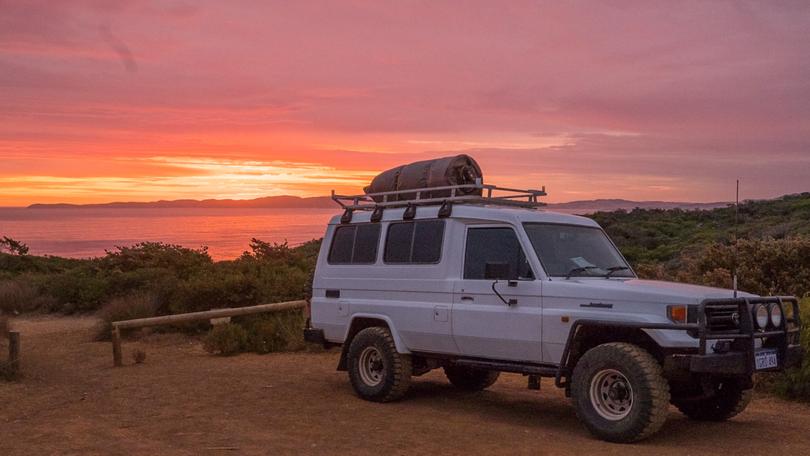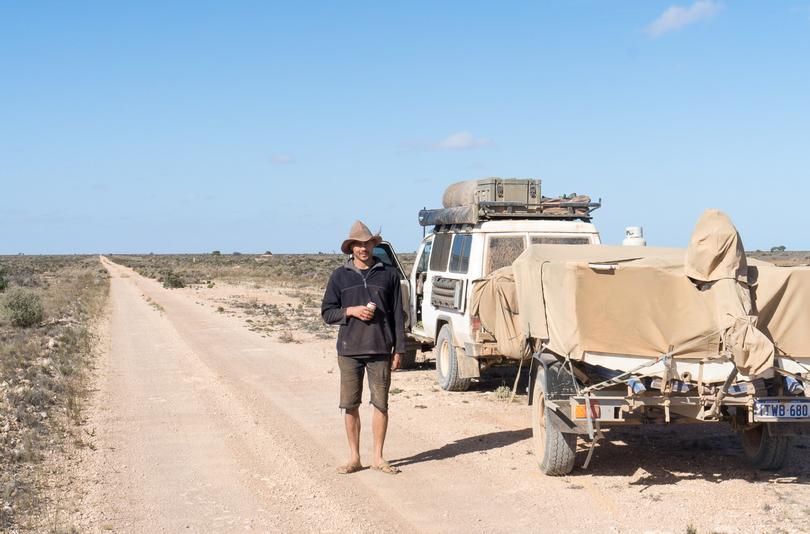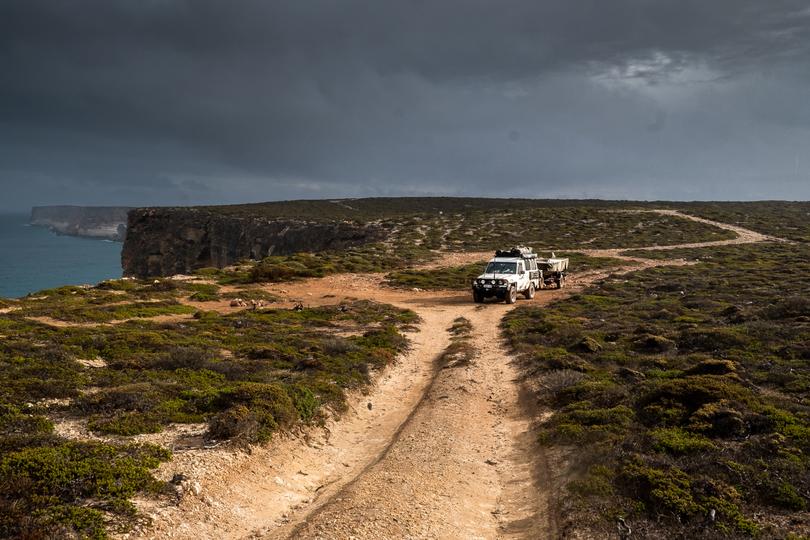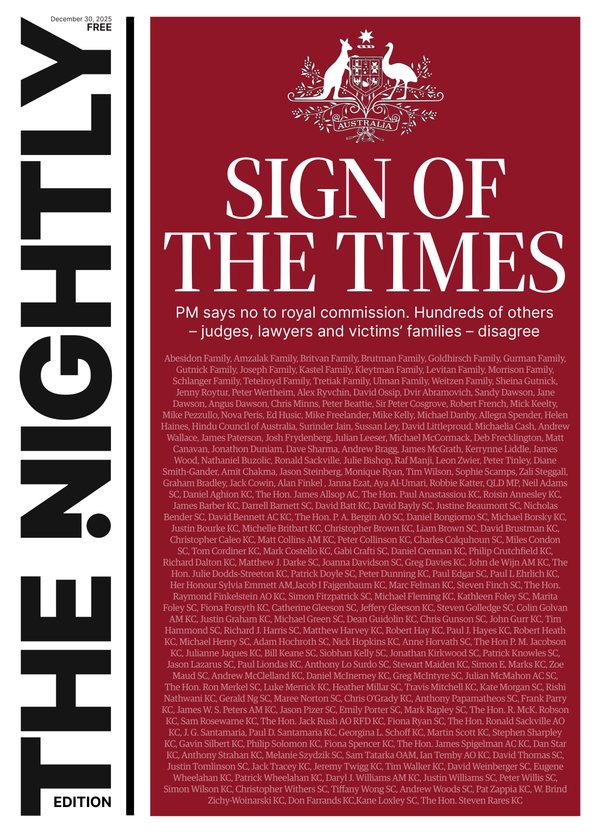The Lap Part 1: Hitting up real Australia takes a real Australian vehicle. The Landcruiser Troopcarrier.

The Lap.
That great Australian dream — the one beyond the white picket fence — of loading up the four-wheel-drive, caravan or camper-trailer or tinny hitched on behind, and following Highway One, the longest national highway in the world, right around the country’s coastline. No plans, destination or pressure. Just one big 15,000km loop around this country’s figurative veranda.
Newly minted tradies, grey nomads, young couples and families: you’ll find Australians of all different kinds taking on The Lap.
But the problem with it is that you’re missing out on 90 per cent of the country. Given that 90 per cent of Australians live on the coast, perhaps there is a vast continent out there way beyond our cities and coastal settlements that many of us have never experienced.
ROAM. Landing in your inbox weekly.
A digital-first travel magazine. Premium itineraries and adventures, practical information and exclusive offers for the discerning traveller.
By continuing you agree to our Terms and Privacy Policy.It’s a place at once beautiful and terrifying in its dimensions with a dangerous freedom as limitless as the horizon stretched out before you. At least, it is for the lucky few anyway. There’s plenty of unlucky ones out there too, backs against the wall but still battling on with a wry smile.
There’s cheeky Pommy geezer, Joey, who claimed this country as his own, and is running liveaboard backpacker tours around the nation. Jay the Pirate of Stanage Bay, a one-legged north Queensland crab fisherman in his tinny battling to stick to the living that he loves. And scattered about them all, the world’s oldest surviving peoples, clinging on to who they are in the wake of colonisation.
I had only a vague idea of the country I would discover when in early 2021, I hit the road indefinitely with my now ex-girlfriend, Dorje, and little old dog, Jezebel. We had only one real goal: to not make this The Lap. We would keep off the main roads, exploring the back tracks and venturing deep beyond what we knew.

There was only ever one choice when it came to a car for this: a Toyota LandCruiser Troopcarrier. This vehicle has been seared into the soul of Australia by legends like Malcolm Douglas, Steve Irwin, Russell Coight. Much of this country is also, quite literally, built upon the back of it.
Its genesis came with the Snowy Mountains hydro-electric scheme, Australia’s largest ever engineering project. Sixteen major dams, nine power stations, two pumping stations, and 225 kilometres of tunnels, pipelines, and aqueducts; all working to generate hydro-electricity from runoff in the Snowies, diverting the rest into scheme irrigation on the western side of the Great Dividing Range.
Building the thing was a bloody nightmare for construction crews. They worked the rough, wooded mountainsides and sodden valleys in Land Rovers and Willy Jeeps and Austin Champs, known at the time as some of the most capable vehicles going. Still, if anyone could break a car, it was a Snowy Mountains construction crew.
The man in charge of it all, civil works contractor, Leslie Thiess, decided to bolster the fleet of UK and US vehicles with several Japanese numbers. In 1959, he imported 13 new Toyota FJ25s Land Cruisers. The vehicles weren’t initially outstanding with their fragile front axles and gearboxes. But the Toyota’s strength was in the manufacturer’s response to the issues, according to then-executive, Alex McArthur, in Toyota Australia’s book, The Long Run.
“When we had trouble, the Japanese immediately came out. They didn’t hesitate, dispatching engineers who lived with us on site until the problems were rectified. They would fly out parts and send broken pieces back to Japan for analysis, to rectify the problem at the source.”
Thiess saw potential for the vehicles in Australia and began importing them in earnest. As more miners, pastoralists, and industrialists began to find themselves behind the wheel of these new Japanese 4WDs, their reputation for quality and durability grew. The vehicle soon became the best-selling body-on-frame 4WD in the country.

In 2019, I had saved enough to begin searching for an old LandCruiser Troopcarrier. The ‘Troopy’ has become an icon among travellers for its space, simplicity, and longevity. Some older models have been known to do in excess of a million kilometres on the original motor and have all mechanical parts, meaning there are no special technical skills or tools required to fix them.
“It’s really a unique vehicle,” says Troopy owner Josh Pelz. “It’s basically a heavy-duty 4x4 panel van, with a similar sentiment to the old Holden panel van, only you can travel to the most remote corners of the country in it.
“The fact they are so basic, and generally just a blank canvas with 11 seats means there is unlimited potential to modify them in a way that suits you. There really are no two Troopies on the road that are the same.”
It is also the preferred vehicle of government bodies and emergency services working in remote areas. In 2005, health worker Josette O’Donnell was working in Katherine when she found herself behind the wheel of one. Immediately, she felt a sense that she was home.
“The first time I got into this truck I was thinking, ‘this is unreal’. To be able to jump in a truck like that and drive out into some wicked places out in the Tanami Desert,” she says.
“It was like I knew who I was, all of a sudden. On the road, in the car, in myself, even. It’s severely practical, particularly in remote Australia.
“Some of the clinics we would visit, you know, you drive seven or eight hours, and then there’s another two hours of four-wheel-driving, river crossings, just to get to the communities and visit the health centre. But the Troopy just handles it beautifully.”
The Troopy has played an important role in Josette’s life, and still remains a central feature even as she now finds herself a single mother to two boys. She bought her own in 2014 after separating with her partner.

“All my friends were making decisions about safe cars for their kids. And I’m thinking, ‘Nah, I might be heading back to the Territory, I’ve gotta get a solid car’. So I bought the Troopy off this chippy in Bayswater (in Melbourne’s outer suburbs). I think he got the shock of his life when he saw this young woman walking up with two kids on either hip, both of them under five.
“I’ve owned the Troopy for 10 years now, and I wonder why the hell any single mother would have any other kind of car. It’s more reliable than any relationship I’ve ever had. People talk about their car being a female, mine is my man. Steadfast, reliable, it’s never let me down. And if something is broken, I know it can be fixed pretty simply.”
I found a 1998 model on Facebook marketplace for $12,500. The bloke selling it was my age, early twenties, and had hoped to convert it into a home-on-wheels before realising he had neither the time nor the capacity for this project.
It had rust from where somebody had crudely fixed a reverse camera straight into the roof skin, but I swallowed his fib that it was all non-structural and an easy fix. The rest of the car had been painted a glossy snow white and was all flash and shiny. A week later, in the Margaret River industrial area, rust repairer Tony set me straight.
“Never buy a vehicle that’s been recently painted. You know, you can’t polish a turd, but you can roll it in glitter.”
I should have been happy with my new shining white glittery turd, but really, I felt overwhelmed. There was so much to do. Fix the rust, build a drawer set-up with a bed and fridge, wire up a 12-volt battery system. Fit a roof-rack, dual-wheel-carrier, bullbar, winch.
And sure, I had plenty of time, but neither the money nor the capacity. Truth was, I didn’t even know how to use a bloody drill. But I was determined to learn, and lucky enough to be in a country where everyone is happy to help mates out.
I bought some basic power tools and found a place to work on the car in my mate Benno’s shed in Karridale, 20km south of Margaret River. Benno bought this little shack in the forest a few years ago. He’d quit his lucrative job as a commercial skipper in north-west WA and was following his dream of milling timber and making furniture.
It was an idyllic life he dreamt of, but Benno underestimated the scale of getting started. Before he could even cut and sand a breadboard he had to put a hot-water system in the house, cut down feral blue gums, plant a veggie garden to sustain himself on minimal income, fix his car, fix the shed, fix the water pump.
It all began to overwhelm him. Soon the bank was knocking at the back door, and things really went south when in the same week he split up with his girlfriend and his dog got run over in front of the pub. He headed back north to drive tour boats in Kununurra.
Benno said the shed was mine whenever I wanted to use it. I spent all my weekends down there. Lodging in Benno’s house was Noam, an Israeli-Australian managing the pub up the road. He sometimes gave me a hand after he’d knocked off work. We spent summer nights tinkering, cold cans in hand, the thwack and murmur of cricket on the radio.
Slowly, things started to come together. After a few late nights, I fixed in a drawer system with a slide out kitchen and car fridge, and a bed on top. One weekend, my sparkie mate came down and gave me a hand to wire up a dual-battery system.

I had no idea how a car could connect me to so many other people, but as I drove around, I started to notice these strange waves from other Troopy drivers. It was a kind of three-fingered salute, thumb and ring finger folded down. Later, I learned from another driver that it was the cult wave of a Facebook group, the Troopcarriers of Australia.
With over 12,000 members, TOA is more of a family than a Facebook group. Many members are mechanics or LandCruiser experts, and offer instant advice when someone shares a particular problem. Others offer beds, sheds, meals, tools and many lifelong friendships have been forged through the bond of an iconic Australian vehicle, says group administrator, Dan van Scherpenseel.
“The group was started by Mick Shaw, as just a forum for like-minded people to connect and share knowledge about their Troopy,” he says. “He quickly found out a lot of Troopy owners are very like-minded. He had lost his finger in a four-square machine. When he waves he’s got a finger down, and so that kicked off and became our cult wave: the ‘Shawry’.”
There is a special quality to the Troopy, says Dan, that means its owners are often so helpful. Travel helps restore a faith in humanity; most people out there are good people willing to help. Troopy owners know this. They’ve been on the road. They understand what it’s like, and are willing to repay the good deeds others have done for them. He is continually amazed by how far that generosity extends.
“When I went to buy my second Troopy, it was a few hours out of Melbourne. When I flew in I wasn’t sure how I was going to get there. I chucked a post up in the group, and within a few minutes had someone offering to drive me out there,” he says.
“No matter where you are in the country there is someone close by, or they know someone, or they’ve got a driveway for you to do a service in. Everyone is so helpful, even though you’ve never met them. I guess that’s the power of such a unique vehicle.”
With the car kitted out, Dorje and I bundled our lives into the back of it and headed east from Margaret River. People said there wasn’t much out there; just spinifex and scrub. But I knew there would be stories. And if I was going to find the soul of Australia, that was the first place to look.
Beyond the Lap Part 2 out Friday.
